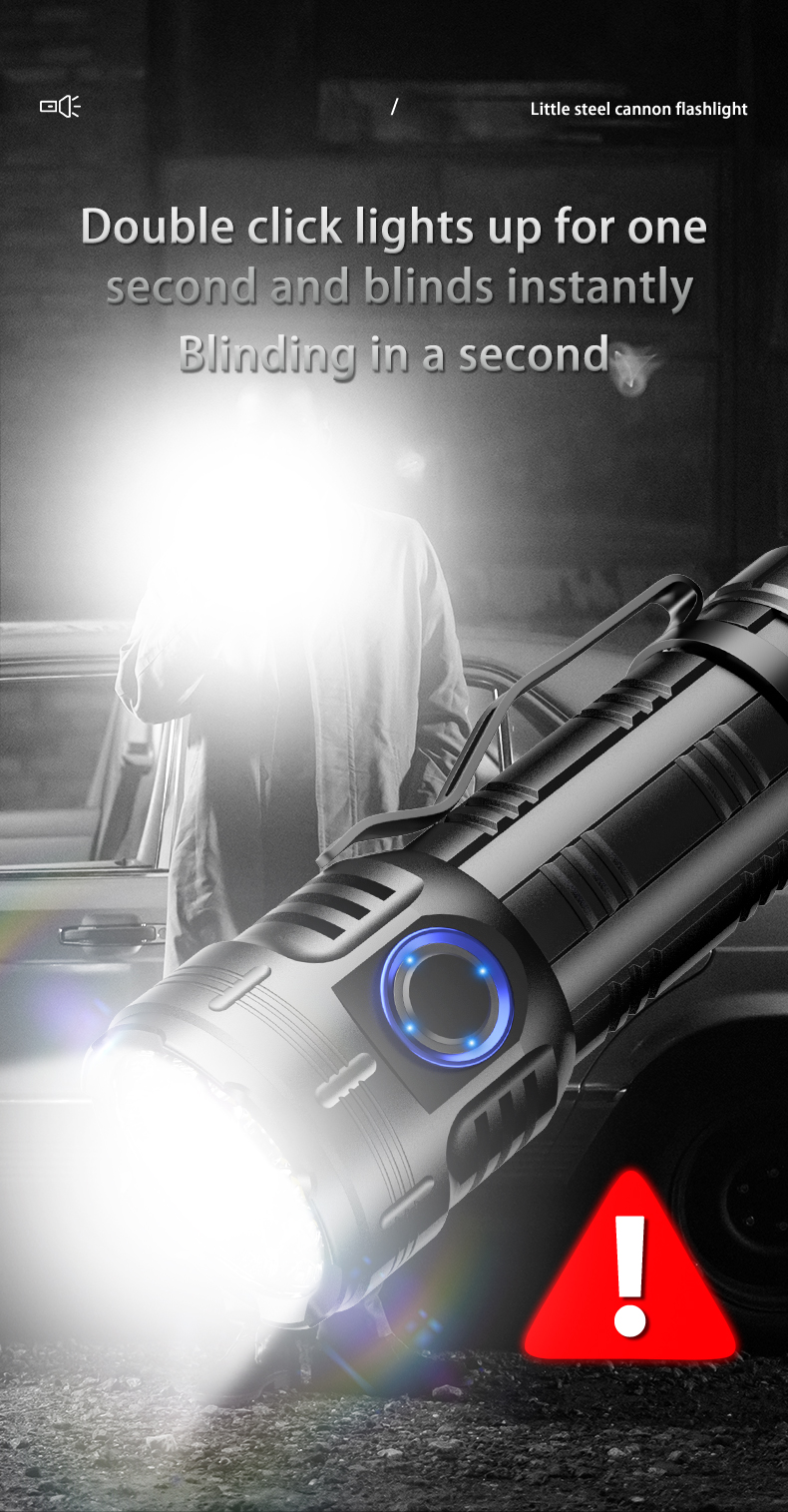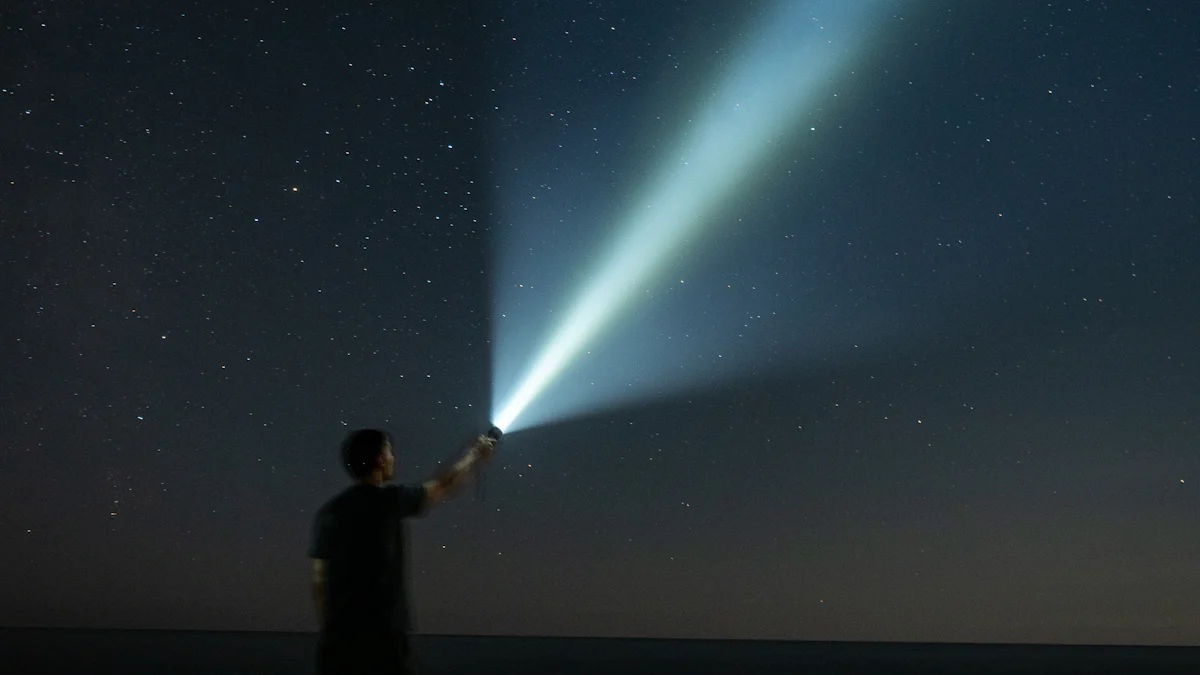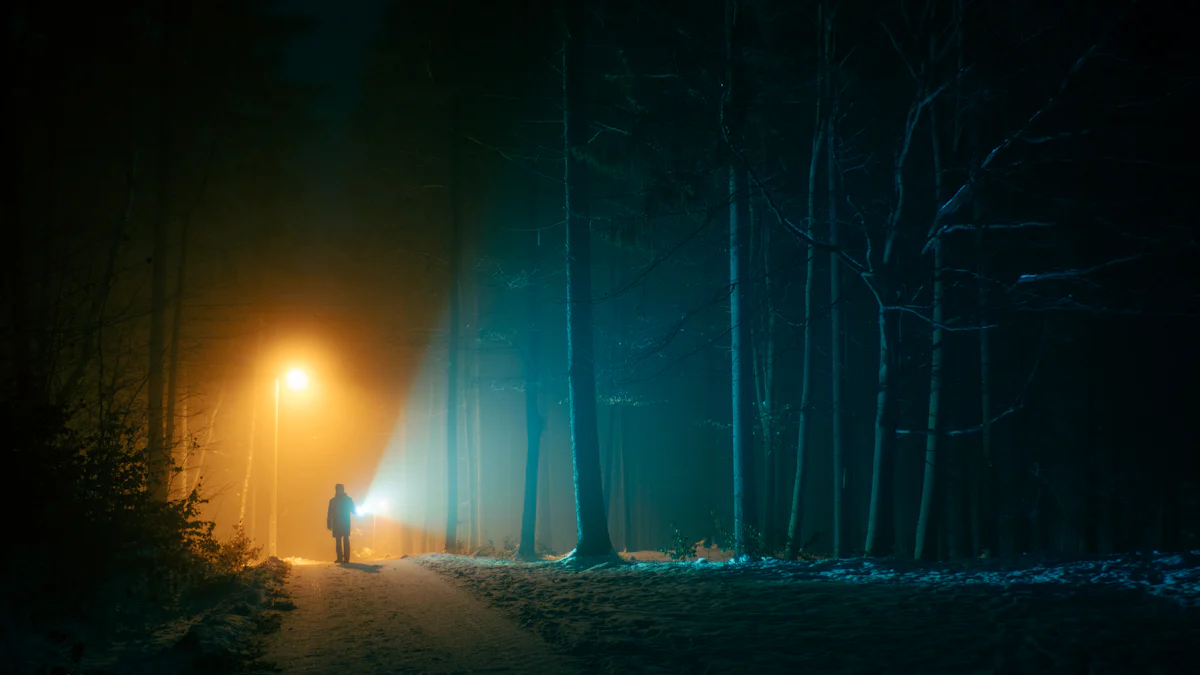Flashlight Features You Didn’t Know You Needed

When you think of a flashlight, you probably picture a tool for lighting up dark spaces. But modern flashlight features go far beyond basic illumination. You don’t always need a brighter flashlight to get the job done. Sometimes, it’s about smarter design and functionality that make your life easier and safer.
Key Takeaways
Think about how far the light shines and if it adjusts. These features help you use the flashlight for camping or emergencies.
Pick one with different brightness modes for various situations. This helps save battery and gives the right amount of light.
Get a flashlight with a lock feature to stop it from turning on by accident. This keeps it ready to use and saves battery.
Rethinking Flashlight Basics
Why Lumens Aren’t Everything
You might think that a flashlight’s brightness is all about lumens, but that’s not the whole story. Lumens measure the total light output, but more lumens don’t always mean better performance. For example, a brighter flashlight with high lumens might flood a room with light but fail to focus on a specific area. That’s where beam pattern and throw come into play. A well-designed flashlight balances lumens with an effective illumination distance, ensuring you get the right light for the task at hand. So, instead of chasing the highest lumens, consider how you’ll use the flashlight and what kind of beam suits your needs.
Beam Distance and Adjustable Beam Features
Beam distance is another critical factor that affects how useful a flashlight is in different scenarios. Whether you’re hiking, camping, or handling emergencies, the right beam distance ensures you can see what’s ahead. Here’s a quick guide to help you understand how beam distance pairs with lumens for various activities:
Lumens | Distance | Best For |
|---|---|---|
1–250 | Up to 80 meters | Everyday and leisure activities in dim conditions |
160–400 | Up to 100 meters | Camping, hiking, backpacking |
400–1000 | Up to 200 meters | Hiking, backpacking, caving, campervan engine repair |
1000–3000 | Up to 350 meters | Fishing, hunting, rock climbing |
3000–7000 | Up to 500 meters | Extreme weather conditions, mountaineering, emergency rescue |
7000–15000 | Up to 700 meters | Extreme weather conditions, emergency rescue, mountaineering, activities that require lighting a large area |
Adjustable beam features add even more versatility. You can switch between a wide floodlight for close-up tasks and a focused spotlight for long-distance visibility. This flexibility makes your flashlight more adaptable to different situations.
Compact vs. Full-Sized Flashlights: Choosing the Right Size
When it comes to flashlight features, size matters. Compact flashlights are lightweight and easy to carry, making them perfect for everyday use or as part of your emergency kit. They’re small enough to fit in your pocket but still pack enough brightness for most tasks. On the other hand, full-sized flashlights offer more power and longer battery life. They’re ideal for outdoor adventures or professional use where you need extended performance. Think about how and where you’ll use your flashlight. If portability is key, go compact. If you need durability and power, a full-sized option might be your best bet.
Operational Features That Make a Difference
Multi-Mode Settings for Versatility
Have you ever needed a flashlight that adapts to different situations? Multi-mode settings are a game-changer. These settings let you switch between multiple brightness levels, so you can choose the right amount of light for the task. For example, a low mode works great for reading a map or preserving your night vision, while a high mode is perfect for lighting up a dark trail. Some flashlights even include a turbo mode for short bursts of intense brightness when you need a brighter flashlight. This versatility ensures you’re not wasting battery power when you don’t need maximum output. Whether you’re camping, working, or dealing with an emergency, having options makes all the difference.
Magnetic Selector Rings for Easy Mode Switching
Fumbling with buttons in the dark can be frustrating. That’s where magnetic selector rings come in handy. These rings allow you to switch modes with a simple twist, making it quick and intuitive to adjust your flashlight’s settings. You don’t have to cycle through every mode to find the one you need. This feature is especially useful when you’re wearing gloves or when time is critical. Plus, it helps you maintain focus on your task instead of struggling with controls. It’s a small detail, but it can make using your flashlight much more efficient.
Lockout Mode: Avoiding Accidental Activation
Have you ever pulled your flashlight out of your bag only to find the battery drained? Lockout mode solves this problem. This feature prevents accidental activation by locking the flashlight’s power button. It’s especially useful when you’re traveling or storing your flashlight in a crowded bag. You won’t have to worry about it turning on and wasting battery life. Lockout mode also protects the flashlight from overheating if it accidentally powers on in a confined space. It’s a simple but essential feature that ensures your flashlight is ready when you need it most.
Specialized Flashlight Features
Red, Green, and Blue Lights: Practical Applications
You’ve probably seen flashlights with red, green, or blue light options, but do you know why they’re useful? Each color serves a unique purpose. Red light is perfect for preserving your night vision. It’s great for stargazing or wildlife observation since it doesn’t startle animals. Green light enhances contrast and depth perception, making it ideal for navigation or hunting. Plus, it’s less likely to attract insects, which is a bonus during outdoor adventures. Blue light, on the other hand, is a multitasker. It improves visual clarity for reading maps or doing detailed work in low light. It’s also handy for detecting fluorescence, like pet stains or forensic evidence. If you’re a diver, you’ll love how blue light cuts through water, improving underwater visibility.
High-CRI Lights for Accurate Color Rendering
Sometimes, you need a flashlight that doesn’t just illuminate but also shows colors as they truly are. High-CRI (Color Rendering Index) lights mimic natural sunlight, making colors appear vibrant and accurate. This feature is a game-changer in settings where color matters. In retail stores, it enhances the shopping experience by making products look their best. In medical facilities, it ensures accurate color perception, which is critical for diagnoses. Even in educational settings, high-CRI lighting keeps students alert and engaged. If you’re working on a project that requires precise color differentiation, this flashlight feature is a must-have.
Strobe and SOS Modes for Emergencies
Emergencies demand quick action, and your flashlight can be a lifesaver. SOS mode flashes the universal distress signal, making it easy for rescuers to spot you from a distance. Some flashlights even pair this with an alarm sound for added visibility. Strobe mode, on the other hand, creates rapid flashes that can disorient potential threats or grab attention in non-emergency situations. Both modes conserve energy, ensuring your flashlight lasts longer when you need it most. Whether you’re stranded or signaling for help, these features turn your flashlight into a reliable survival tool.
Durability and Build Quality

Waterproof Ratings: Understanding IPX Standards
When it comes to flashlights, waterproofing is a feature you’ll appreciate more than you think. Whether you’re caught in a sudden downpour or accidentally drop your flashlight in water, understanding IPX ratings can help you choose the right level of protection. Here’s a quick breakdown:
IPX4: Protects against water splashes from any direction. Great for light rain or everyday use.
IPX5: Resists low-pressure water jets. Perfect for environments with frequent water exposure.
IPX6: Handles powerful water jets. Reliable in extreme weather conditions.
IPX7: Submersible up to 1 meter for 30 minutes. Ideal for accidental water drops.
IPX8: Designed for continuous immersion beyond 1 meter. A must-have for deep-sea diving or prolonged underwater use.
If you’re planning outdoor adventures or working in wet conditions, a higher IPX rating ensures your flashlight stays functional when you need it most.
Impact Resistance for Tough Conditions
Durability isn’t just about waterproofing. A flashlight’s ability to withstand drops and impacts is equally important. Imagine dropping your flashlight on rocky terrain during a hike. Without impact resistance, it might stop working right when you need it. Look for flashlights tested to survive drops from specific heights, often listed in product descriptions. This feature ensures your flashlight can handle tough conditions, whether you’re camping, working on a construction site, or just dealing with everyday mishaps.
Material Choices: Aluminum, Plastic, and Stainless Steel
The material of your flashlight plays a big role in its durability and weight. Aluminum is a popular choice because it’s lightweight yet strong. It resists corrosion, making it ideal for outdoor use. Plastic flashlights are lighter and often more affordable, but they may not hold up as well in rugged conditions. Stainless steel, on the other hand, offers maximum durability. It’s heavier but perfect for professional-grade flashlights or situations where toughness is a priority. Think about how you’ll use your flashlight and choose a material that balances durability, weight, and portability.
Unique Applications of Flashlights
Flashlights for Self-Defense
Did you know your flashlight can double as a self-defense tool? Modern designs include features that make them surprisingly effective in emergencies. For instance, some flashlights are up to 100 times brighter than older models. This level of brightness can temporarily blind an attacker, giving you time to react. Many also come with strobe mode, which produces rapid flashes to disorient threats.
Some flashlights even feature crenulated bezels—those jagged edges around the lens. These are designed for striking, making them a practical option for self-defense. Plus, durable construction ensures they’re waterproof and shock-resistant, so they’ll hold up in tough conditions. Whether you’re walking alone at night or preparing for the unexpected, a flashlight can be more than just a light source.
Feature | Description |
|---|---|
Brightness | Can blind an assailant temporarily. |
Crenulated Bezels | Acts as a striking tool in emergencies. |
Disorients threats with rapid flashes. | |
Waterproof and Shock-Resistant | Ensures reliability in challenging environments. |
Professional-Grade Flashlights for Specific Tasks
If you’re in a profession that demands reliability, a standard flashlight won’t cut it. Professional-grade flashlights are built for specific tasks. Emergency personnel and firefighters rely on models with high luminous intensity to navigate dark, hazardous areas. These flashlights are often waterproof, dustproof, and even explosion-proof, making them ideal for extreme conditions.
Durability is another key feature. They’re designed to withstand impacts and vibrations, so you don’t have to worry about dropping them. Many also include large magnetic switches, allowing you to operate them easily—even while wearing gloves. Despite their robust build, these flashlights are lightweight and compact, making them easy to carry in a backpack.
Everyday Carry (EDC) Flashlights for Convenience
For everyday use, you need a flashlight that’s compact, efficient, and easy to carry. EDC flashlights check all these boxes. Their small size means they fit comfortably in your pocket or purse, so they’re always within reach. Despite their size, they pack a punch with LED bulbs that offer impressive brightness.
Adjustable focus is another handy feature. It lets you switch between a wide beam for general visibility and a focused beam for specific tasks. Long battery life is also a must, especially if you’re using rechargeable batteries. Finally, ergonomic designs with textured grips ensure comfort during extended use. Whether you’re walking your dog at night or fixing something in a dimly lit space, an EDC flashlight is a reliable companion.
Modern Innovations in Flashlights

USB Charging for Convenience and Sustainability
USB charging has revolutionized how you power your flashlight. Instead of hunting for replacement batteries, you can simply plug your flashlight into any USB port. Whether it’s your laptop, car, or a portable power bank, recharging becomes effortless. This feature is especially handy when you’re on the go or in remote areas. Plus, using rechargeable batteries isn’t just convenient—it’s also eco-friendly. By reducing the need for disposable batteries, you’re cutting down on waste and helping the environment. It’s a win-win for both you and the planet.
Emergency Glass-Breaking Features
Imagine being trapped in a car during an emergency. A flashlight with a glass-breaking feature could be your lifesaver. These flashlights often have a hardened tip designed to shatter glass with minimal effort. It’s a practical tool for escaping a vehicle or helping someone in distress. You don’t need to be a professional rescuer to appreciate this feature. It’s a small addition that can make a big difference when seconds count. Keep one in your car or emergency kit, and you’ll always be prepared for the unexpected.
Compact Designs with Enhanced Portability
Modern flashlights are getting smaller but smarter. Compact designs make it easy to carry your flashlight wherever you go. They fit snugly in your pocket, purse, or even on a keychain. Despite their size, these flashlights deliver impressive brightness, rivaling larger models. Many also feature lightweight materials, so they won’t weigh you down during outdoor adventures. Portability doesn’t mean sacrificing functionality. You’ll still find features like adjustable beams and long-lasting battery life in these tiny powerhouses. A compact flashlight ensures you’re always ready, whether you’re exploring the outdoors or navigating a power outage.
Choosing the right flashlight can make a world of difference. Features like adjustable brightness, long battery life, and durable materials ensure you’re ready for any situation. Compact designs and user-friendly controls add convenience to your daily life. Explore advanced flashlight features to match your specific needs. The right flashlight isn’t just a tool—it’s a game-changer for both everyday tasks and emergencies.
FAQ
What flashlight features are best for outdoor adventures?
Look for waterproofing, impact resistance, and adjustable beams. These features ensure your flashlight performs well in unpredictable weather and rugged terrains. 🌧️🏕️
How do I maintain my flashlight for long-term use?
Clean the lens and body regularly.
Store it in a dry place.
Recharge or replace batteries as needed.
Tip: Use lockout mode to prevent accidental activation! 🔒
Are rechargeable flashlights better than battery-operated ones?
Rechargeable flashlights are eco-friendly and cost-effective. They save you from buying disposable batteries and are easy to charge via USB. ♻️🔋
See Also
Explore Various Styles of Flashlights Available Today
SF1 Camping Flashlight: Light Up Your Outdoor Experiences
Experience Hands-Free Fun With Multi-Color LED Flashlight
